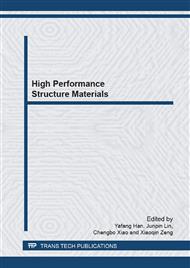[1]
Feng Q, Tryon B, Carroll L J, Pollock T M. Cyclic oxidation of Ru-containing single crystal superalloys at 11000C [J]. Materials Science and Engineering A, 2007, 458: 184-194.
DOI: 10.1016/j.msea.2006.12.064
Google Scholar
[2]
G.L. Erickson, A New Third Generation Single-Crystal Casting Superalloy. JOM, vol. 47, No. 4, TMS. Warrendale, PA, April 1995, p.36.
DOI: 10.1007/bf03221147
Google Scholar
[3]
G.E. Fuchs, B.A. Boutwell, Mater. Sci. Eng., A Struct. Mater.: Prop. Microstruct. Process. 333(2002) 72.
Google Scholar
[4]
D.N. Duhl, in:C.T. Sims, N.S. Stoloff, W.C. Hagel(Eds. ), Superalloys П, Wiley and Sons, Inc., New York, 1987, p.189.
Google Scholar
[5]
G.E. Fuchs, Mater. Sci. Eng., A Struct. Mater.: Prop. Microstruct. Process. 300(2001) 52.
Google Scholar
[6]
H. Zhou, Y. Ro, H. Harada, Y. Aoki, M. Arai, Mater. Sic. Eng., A Struct. Mater.: Prop. Microstruct. Process. 381(2004) 80.
Google Scholar
[7]
M. Durand-Charee, The microstructure of superalloys, Gordon and Breach Science Publishers, Canada, 1997, p.60.
Google Scholar
[8]
K. Chen, L.R. Zhao, John S. Tse, Mater. Sic. Eng., A Struct. Mater.: Prop. Microstruct. Process. 365(2004) 80.
Google Scholar
[9]
C.T. Liu X.F. Sun, H.R. Guan Z.Q. Hu, Surf. Coat. Technol. 1994(2005) 111.
Google Scholar
[10]
N. Czech,F. Schmitz, W. Stamm, Surf. Coat. Technol. 68/69(1994) 17.
Google Scholar
[11]
MACKAY R A, NATHAL M V, PEARSON D D. Influence of molybdenum on the creep properties nickel-base superalloy single crystals [J]. Metallurgical Transactions A, 1990, 21: 381-387.
DOI: 10.1007/bf02782418
Google Scholar
[12]
MACKAY R A, NATHAL M V. [C]/ Micon 86: Optimization of processing properties, and service performance through microstructural control. Philadelphia: ASTM, 1988: 202-210.
DOI: 10.1520/stp29129s
Google Scholar
[13]
GIAMEI A F, PEARSON D D, ANTON D L. High temperature ordered intermetallic alloys [M]. Pittsburgh: MRS, 1985: 293-308.
Google Scholar
[14]
D. Blavette, P. Carton, T. Khan, Scripta Metall. 20(1986) 1395.
Google Scholar
[15]
M.S. A Karunaratne, R.C. Reed, Acta Mater. 51 (2003) 2905.
Google Scholar
[16]
A. Sato, Harada, T. Kobayashi, T. Murakumo, J.X. Zhang and T. Yokokawa: J. Jpn Inst. Met., 2005, 70, 196-199.
Google Scholar
[17]
T. Hino, Y. Yoshioka, K. Nagata, H. Kashiwaya, T. Kobayashi, Y. Koizumi, H. Harada and T. Yamagata: in Materials for advanced power engineering, 1129-1137; 1998, Liege.
Google Scholar
[18]
N. Birks, Meier, G.H. Pettit, S.F. Introduction to the High Temperature Oxidation of Metals. 2nd edition. Cambridge Univ Pr, (2006).
Google Scholar


